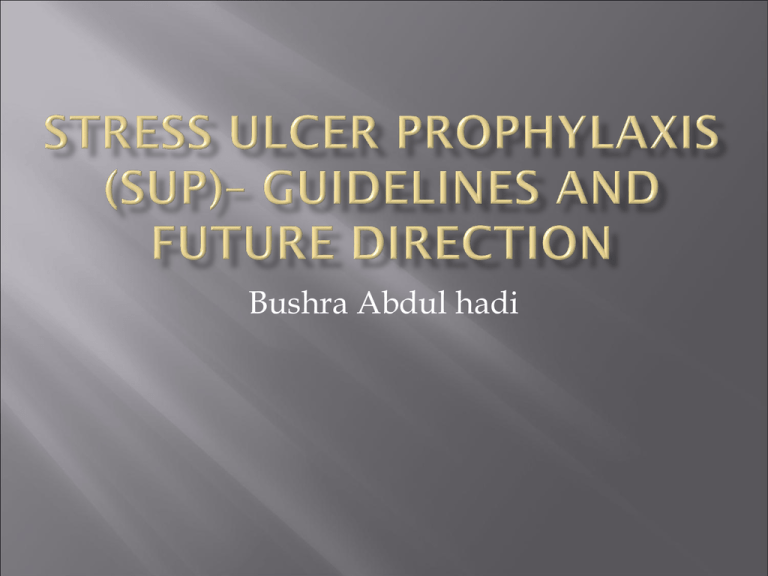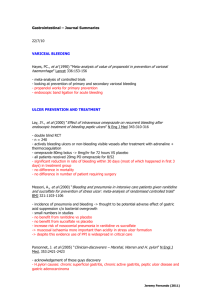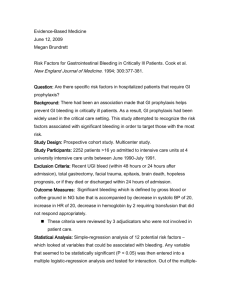Bushra Abdul hadi
advertisement

Bushra Abdul hadi Epidemiology Pathophysiology Current Guidelines & Evidence Agent Selection & Administration Complications Applications For our purposes Gastrointestinal ulcerations of the upper alimentary tract Stomach Duodenum Ileum Jejunum Macroscopic bleeding ASHP Therapeutic Guidelines on Stress Ulcer Prophylaxis, AJHP 1999;56(4) 347-379 1. 2. Up through the 1970 stress ulcers were much more common (>30% of ICU patients) Today, less than 5% of ICU patients have stress ulcers with macroscopic bleeding ASHP Therapeutic Guidelines on Stress Ulcer Prophylaxis, AJHP 1999;56(4) 347-379 Del Valle, J. Chapter 287 - Peptic Ulcer Disease and Related Disorders , Harrison's Principles of Internal Medicine - 17th Ed. (2008). Etiology is complex Decreased Gastric pH Ischemia Decreased mucous production Usually occur within 24-48 hours of trauma/stress Gastric pH is a factor and a surrogate marker, not the root cause of stress ulcers Del Valle, J. Chapter 287 - Peptic Ulcer Disease and Related Disorders , Harrison's Principles of Internal Medicine - 17th Ed. (2008). Cook and collegues conducted a large (n=2252) multicenter prospective trial evaluating the risk factors of significant bleeding Mortality for patients with a significant bleed 48.5% with significant bleeding 9.1% without significant bleeding Cook DJ, et al. Risk factors for gastrointestinal bleeding in critically ill patients. NEJM 1994;330(6):377-81 Two independent factors for a clinically significant bleed: Incidence of significant bleeds Respiratory failure (OR=15.6) Coagulopathy (OR=4.3) With one or both risk factors 3.7% Without either risk factor 0.1% Number need to treat for significant bleeding Without risk factors = 900 risk for factors = 30 Cook DJ,et With al. Risk factors gastrointestinal bleeding in critically ill patients. NEJM 1994;330(6):377-81 ASHP Therapeutic Guidelines on Stress Ulcer Prophylaxis 1. Coagulopathy 2. Mechanical Ventilation 3. platelet count of <50,000mm3 INR>1.5 PTT of >2 times the control Longer than 24 hours Recent GI ulcers/bleeding Within 12 months of admission ASHP Therapeutic Guidelines on Stress Ulcer Prophylaxis, AJHP 1999;56(4) 347-379 2 or more of the following: Sepsis ICU>1 week Occult Bleeding within 6 days High dose corticosteroids 1. 2. 3. 4. 250mg Hydrocortisone 50mg Methylprednisone These factors are not consistently found to be contributing factors, but they are significant in some studies ASHP Therapeutic Guidelines on Stress Ulcer Prophylaxis, AJHP 1999;56(4) 347-379 One of the early identified causes of stress ulcers was sepsis (n=30) Significant for Incidence Severity Ulcers rapidly resolved after sepsis resolved Le Gall JR, et al. Acute gastroduodenal lesions related to severe sepsis. Surgery, Gynecology & Obstetrics. 142(3):377-80, 1976 Mar. Study of patients in the ICU on mechanical ventilation (n=179) Patients with significant GI Bleeding (14%) had Longer stays (14 vs. 4 days) Longer ventilation time (9 vs. 4 days) Only 3% of patients with stays less than 5 days had GI Bleeing events Schuster DP. Rowley H. Feinstein S. McGue MK. Zuckerman GR . Prospective evaluation of the risk of upper gastrointestinal bleeding after admission to a medical intensive care unit. American Journal of Medicine. 76(4):623-30, 1984 Apr. Prospective, small (n=100) non-randomized study evaluating magaldrate (an antiacid) for SUP Mechanical ventilation and high dose steroids found to be significant factors Cook (1994) found steroids to not be a factor Estruch R, et al. Prophylaxis of gastrointestinal tract bleeding with magaldrate in patients admitted to a general hospital ward. Scandinavian Journal of Gastroenterology. 26(8):819-26, 1991 Aug. Big 3 1. 2. 3. 1. 2. 3. 4. Coagulopathy Mechanical Ventilation GI Bleeding within 12 months Little 4 (2 or more) Sepsis ICU>1 week Occult Bleeding within 6 days High dose corticosteroids For the most part, the agents used are not FDA approved, so definitive dosing is difficult Most studies used typical GERD/erosive esophagitis dosing None used beyond maximum recommended daily dose IV Agents Pantoprazole 40 mg (Q12-24h) Ranitidine 50mg (Q8h) Oral Agents Omeprazole 40mg (Q24h) Powder for suspension is FDA Approved! Ranitidine 150mg (Q12h) Sucralfate 1-2 grams 4 times per day Hey this one has an FDA indication! Proton Pump Inhibitors, High-dose, Criteria for Use, VHA Pharmacy Benefits Management Strategic Healthcare Group and the Medical Advisory Panel ASHP guidelines note that durations vary widely by study Cook’s seminal prospective trial defined SUP as 2 or more doses of a H2RA, PPI, or antacid. The pathophysiology suggests that duration of therapy as short as 2-3 days may be sufficient Clinical prudence might be to continue therapy as long as risk factors are present Cook DJ, et al. Risk factors for gastrointestinal bleeding in critically ill patients. NEJM 1994;330(6):377-81 1. 2. 3. 4. Hospital Acquired Pneumonia(HAP)1 C Difficile2 Osteoporosis & Hip Fractures3,4 Herzig HJ et al, JAMA 2009;301(20):2120-2128 Dial, S, Delaney, AC, Barkun AN, et al. JAMA 2005;294(3):2989-2995 Yang et al. JAMA 2006:296(24):2947-2953 Targownik, LE et al. CMAJ 2008:179(4):319-326 Prospective (n=63,878)pharmacoepidemiologic cohort study Excluding ICU Patients PPIs associated with a significant 30% increase in HAP H2RA association was not significant after multivariate analysis Shoshana J. Herzig; Michael D. Howell; Long H. Ngo; et al, Acid-Suppressive Medication Use and the Risk for Hospital-Acquired Pneumonia JAMA 2009;301(20):2120-2128 Case-Control study in the UK showing an increased risk associated with acid suppressive therapy Dial, S, Delaney, AC, Barkun AN, et al. Use of gastric Acid-Suppressive Agents and the Risk of Community-Acquired Clostridium Difficile-Associated Disease. JAMA 2005;294(3):2989-2995 Significant increase in the risk of hip fracture in high dose PPI (>1.75 average dose) Significant increase in risk of hip fractures with use of PPI over 5 years Yang et al. JAMA 2006:296(24):2947-2953 Case (n=15,792)-Control(n=47,289) study Targownik, LE et. al CMAJ 2008:179(4):319-326 One year mortality in men with a hip fracture may be as low as 50% Diamond, TH, et al. The Medical Journal of Australia1997; 167: 412-415 Document the indication for ongoing therapy Discontinue therapy if not indicated Big 3 Little 4 Reduce the risk to patients Reduce costs Discuss the indications with the patient/provider Appropriate indications and duration of therapy Give Stress Ulcer Prophylaxis therapy when indicated Discontinue Stress Ulcer Prophylaxis when no longer indicated Stress Ulcer have a high mortality (nearly ½) Big 3, Little 4 Stress Ulcer Prophylaxis has risks (HAP, C diff, Osteoporosis), in and outside the facility Document, Discontinue, Discuss








